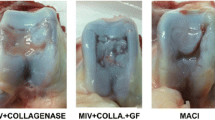Abstract
Articular cartilage (AC) heals poorly and effective host-tissue integration after reconstruction is a concern. We have investigated the ability of implanted chondrocytes to attach at the site of injury and to be incorporated into the decellularized host matrix adjacent to a defect in an in vitro human explant model. Human osteochondral dowels received a standardized injury, were seeded with passage 3 chondrocytes labelled with PKH 26 and compared with two control groups. All dowels were cultured in vitro, harvested at 0, 7, 14 and 28 days and assessed for chondrocyte adherence and migration into the region of decellularized tissue adjacent to the defects. Additional evaluation included cell viability, general morphology and collagen II production. Seeded chondrocytes adhered to the standardized defect and areas of lamina splendens disruption but did not migrate into the adjacent acellular region. A difference was noted in viable-cell density between the experimental group and one control group. A thin lattice-like network of matrix surrounded the seeded chondrocytes and collagen II was present. The results indicate that cultured human chondrocytes do indeed adhere to regions of AC matrix injury but do not migrate into the host tissue, despite the presence of viable cells. This human explant model is thus an effective tool for studying the interaction of implanted cells and host tissue.




Similar content being viewed by others
References
Alford JW, Cole BJ (2005) Cartilage restoration, part 1: basic science, historical perspective, patient evaluation, and treatment options. Am J Sports Med 33:295–306
Archer CW, Redman S, Khan I, Bishop J, Richardson K (2006) Enhancing tissue integration in cartilage repair procedures. J Anat 209:481–493
Brooks PM (2002) Impact of osteoarthritis on individuals and society: how much disability? Social consequences and health economic implications. Curr Opin Rheumatol 14:573–577
Buckwalter JA (2002) Articular cartilage injuries. Clin Orthop Relat Res 402:21–37
Buckwalter JA (2003) Sports, joint injury, and posttraumatic osteoarthritis. J Orthop Sports Phys Ther 33:578–588
Buckwalter JA, Martin JA (2004) Sports and osteoarthritis. Curr Opin Rheumatol 16:634–639
Buckwalter JA, Simon S, Einhorn TA (2000) Orthopaedic basic science: biology and biomechanics of the musculoskeletal system. American Academy of Orthopaedic Surgeons, Rosemont
Chang C, Lauffenburger DA, Morales TI (2003) Motile chondrocytes from newborn calf: migration properties and synthesis of collagen II. Osteoarthritis Cartilage 11:603–612
Davies LC, Blain EJ, Caterson B, Duance VC (2008) Chondroitin sulphate impedes the migration of a sub-population of articular cartilage chondrocytes. Osteoarthritis Cartilage 16:855–864
Elder E, Chen Z, Ensley A, Nerem R, Brockbank K, Song Y (2005) Enhanced tissue strength in cryopreserved, collagen-based blood vessel constructs. Transplant Proc 37:4625–4629
Griffith LG, Naughton G (2002) Tissue engineering—current challenges and expanding opportunities. Science 295:1009–1014
Hunziker EB (2002) Articular cartilage repair: basic science and clinical progress. A review of the current status and prospects. Osteoarthritis Cartilage 10:432–463
Hunziker EB, Rosenberg LC (1996) Repair of partial-thickness defects in articular cartilage: cell recruitment from the synovial membrane. J Bone Joint Surg Am 78:721–733
Hunziker EB, Quinn TM, Hauselmann HJ (2002) Quantitative structural organization of normal adult human articular cartilage. Osteoarthritis Cartilage 10:564–572
Hunziker EB, Kapfinger E, Geiss J (2007) The structural architecture of adult mammalian articular cartilage evolves by a synchronized process of tissue resorption and neoformation during postnatal development. Osteoarthritis Cartilage 15:403–413
Langer R, Tirrell DA (2004) Designing materials for biology and medicine. Nature 428:487–492
Lee GM, Loeser RF (1999) Cell surface receptors transmit sufficient force to bend collagen fibrils. Exp Cell Res 248:294–305
Lutolf MP, Hubbell JA (2005) Synthetic biomaterials as instructive extracellular microenvironments for morphogenesis in tissue engineering. Nat Biotechnol 23:47–55
Maniwa S, Ochi M, Motomura T, Nishikori T, Chen J, Naora H (2001) Effects of hyaluronic acid and basic fibroblast growth factor on motility of chondrocytes and synovial cells in culture. Acta Orthop Scand 72:299–303
Meyer U, Buchter A, Wiesmann HP, Joos U, Jones DB (2005) Current strategies for articular cartilage repair. Eur Cell Mater 9:39–49
Morales TI (2007) Chondrocyte moves: clever strategies? Osteoarthritis Cartilage 15:861–871
Outerbridge RE (1961) The etiology of chondromalacia patellae. J Bone Joint Surg Br 43B:752–757
Pabbruwe MB, Esfandiari E, Kafienah W, Tarlton JF, Hollander AP (2009) Induction of cartilage integration by a chondrocyte/collagen-scaffold implant. Biomaterials 30:4277–4286
Qiu W, Murray MM, Shortkroff S, Lee CR, Martin SD, Spector M (2000) Outgrowth of chondrocytes from human articular cartilage explants and expression of alpha-smooth muscle actin. Wound Repair Regen 8:383–391
Quinn TM, Hunziker EB (2002) Controlled enzymatic matrix degradation for integrative cartilage repair: effects on viable cell density and proteoglycan deposition. Tissue Eng 8:799–806
Quinn TM, Hunziker EB, Hauselmann HJ (2005) Variation of cell and matrix morphologies in articular cartilage among locations in the adult human knee. Osteoarthritis Cartilage 13:672–678
Redman SN, Dowthwaite GP, Thomson BM, Archer CW (2004) The cellular responses of articular cartilage to sharp and blunt trauma. Osteoarthritis Cartilage 12:106–116
Reginster JY (2002) The prevalence and burden of arthritis. Rheumatology (Oxford) 41(Supp 1):3–6
Tew SR, Kwan AP, Hann A, Thomson BM, Archer CW (2000) The reactions of articular cartilage to experimental wounding: role of apoptosis. Arthritis Rheum 43:215–225
van der Kraan PM, Buma P, van Kuppevelt T, van den Berg WB (2002) Interaction of chondrocytes, extracellular matrix and growth factors: relevance for articular cartilage tissue engineering. Osteoarthritis Cartilage 10:631–637
Winnemoller M, Schmidt G, Kresse H (1991) Influence of decorin on fibroblast adhesion to fibronectin. Eur J Cell Biol 54:10–17
Author information
Authors and Affiliations
Corresponding author
Additional information
This study was conducted at the University of Alberta, Edmonton, Canada and was funded by the Edmonton Orthopaedic Research Committee, the Canadian Orthopaedic Foundation, and the Clinical Investigators Program of the Royal College of Physicians and Surgeons of Canada.
Rights and permissions
About this article
Cite this article
Secretan, C., Bagnall, K.M. & Jomha, N.M. Effects of introducing cultured human chondrocytes into a human articular cartilage explant model. Cell Tissue Res 339, 421–427 (2010). https://doi.org/10.1007/s00441-009-0901-z
Received:
Accepted:
Published:
Issue Date:
DOI: https://doi.org/10.1007/s00441-009-0901-z




